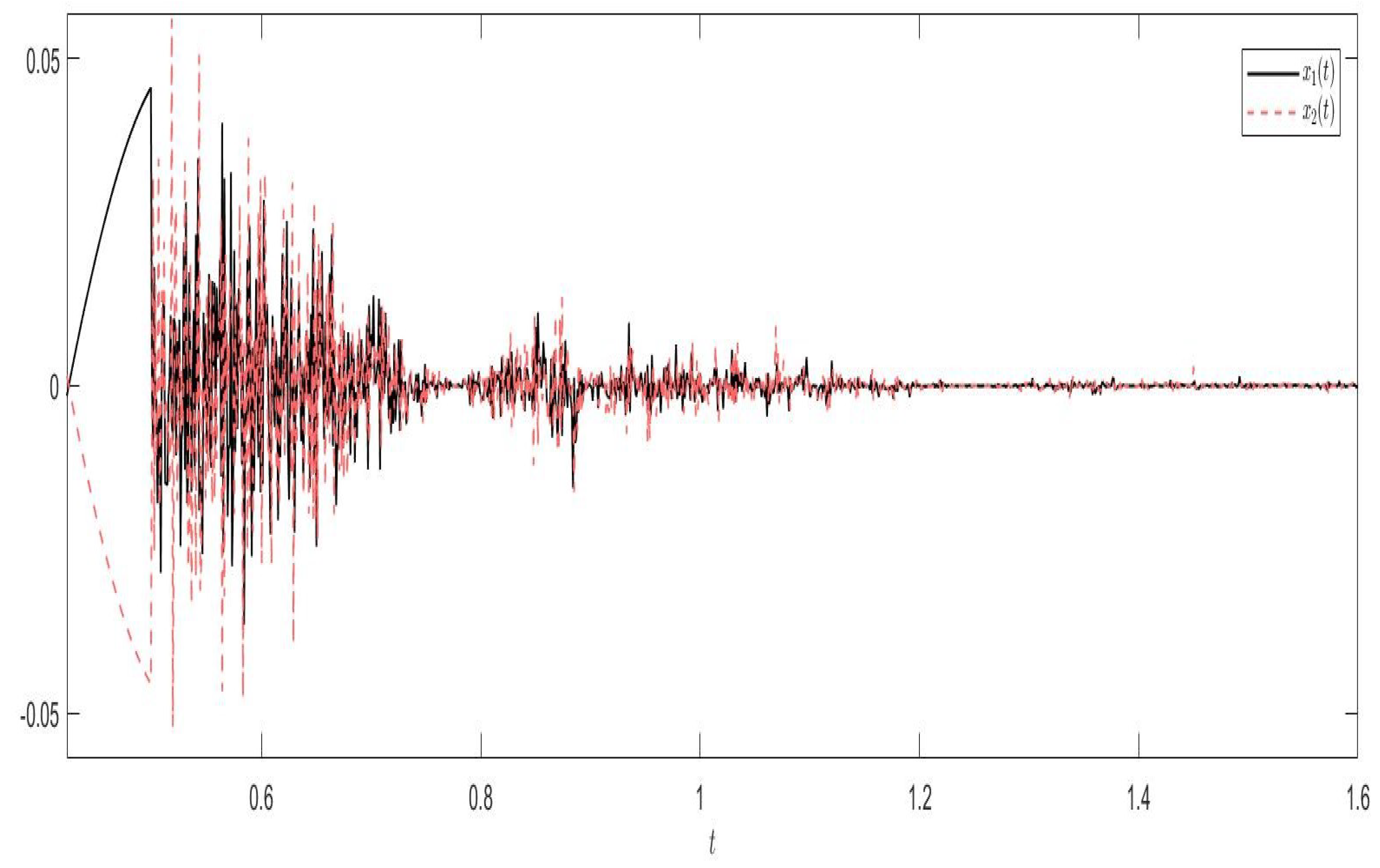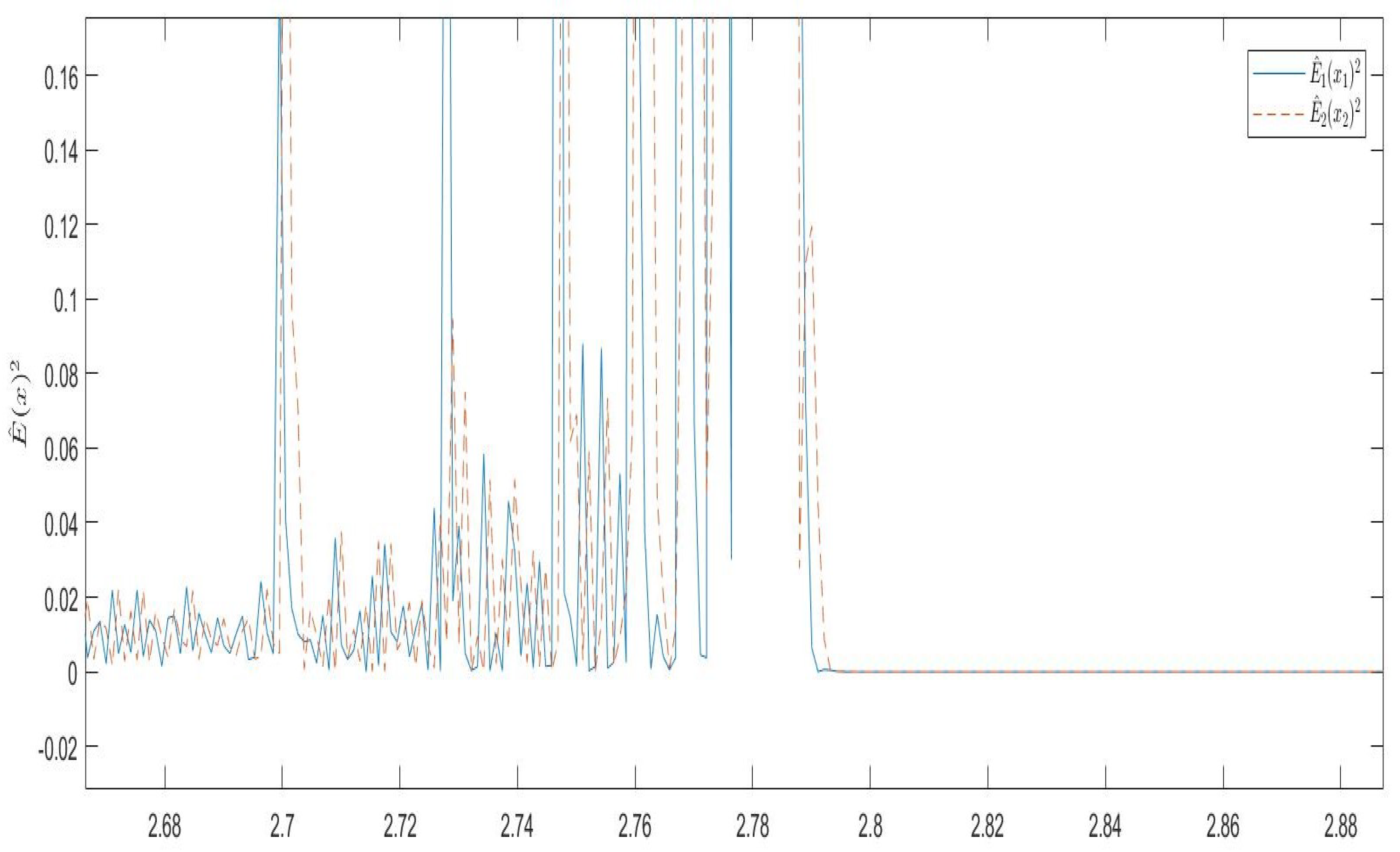Mean-Square Stability of Uncertain Delayed Stochastic Systems Driven by G-Brownian Motion
Abstract
:1. Introduction
- (1)
- This study investigates the stability criterion of G-SDDEs in the context of coefficient uncertainty, offering a comprehensive understanding of how variable coefficients impact system stability.
- (2)
- Unlike previous research that typically imposes specialized conditions on the G function within their premises, our study innovatively addresses the G function without imposing any specific constraints. This approach, while offering a broader understanding, undeniably introduces considerable challenges to our research.
2. Definitions and Preliminaries
- (1)
- Monotonicity: If and , then .
- (2)
- Maintaining constants: .
- (3)
- Subadditivity: .
- (4)
- Positive homogeneity: .
- (1)
- .
- (2)
- ().
- (1)
- For all , we have .
- (2)
- There exist positive constants and such that .
- (1)
- , there exist a constant such that
- (2)
- There exist constants such thatthen system (1) is mean-square exponentially stable.
- (1)
- .
- (2)
- .
- (3)
- .
3. Existence and Uniqueness Theorem
- (1)
- (2)
- (3)
- and
- (4)
4. Main Results
5. Numerical Examples
6. Conclusions
Author Contributions
Funding
Data Availability Statement
Conflicts of Interest
References
- Gu, K.; Kharitonov, V.L.; Jie, C. Stability of Time-Delay Systems; BBirkhuser: Boston, MA, USA, 2003. [Google Scholar]
- Niculescu, S.I. Delay Effects on Stability: A Robust Control Approach; Springer Science & Business Media: Berlin/Heidelberg, Germany, 2001. [Google Scholar]
- Ghaoui, L.E. State-feedback control of systems with multiplicative noise via linear matrix inequalities. Syst. Control. Lett. 1995, 24, 223–228. [Google Scholar] [CrossRef]
- Li, G.; Zhang, Y.; Guan, Y.; Li, W. Stability analysis of multi-point boundary conditions for fractional differential equation with non-instantaneous integral impulse. Math. Biosci. Eng. 2023, 20, 7020–7041. [Google Scholar] [CrossRef] [PubMed]
- Zhu, Q.; Kong, F.; Cai, Z. Special Issue “Advanced Symmetry Methods for Dynamics, Control, Optimization and Applications”. Symmetry 2023, 15, 26. [Google Scholar] [CrossRef]
- Li, T.; Guo, L.; Zhang, Y. Delay-range-dependent robust stability and stabilization for uncertain systems with time-varying delay. Int. J. Robust Nonlinear Control. 2008, 18, 1372–1387. [Google Scholar] [CrossRef]
- Wang, B.; Zhu, Q.; Li, S. Stability analysis of discrete-time semi-Markov jump linear systems with time delay. IEEE Trans. Autom. Control. 2020, 65, 5415–5421. [Google Scholar] [CrossRef]
- Orihuela, L.; Millan, P.; Vivas, C.; Rubio, F.R. Robust stability of nonlinear time-delay systems with interval time varying delay. Int. J. Robust Nonlinear Control. 2011, 21, 709–724. [Google Scholar] [CrossRef]
- Zhu, Q.; Huang, T. H∞ control of stochastic networked control systems with time-varying delays: The event-triggered sampling case. Int. J. Robust Nonlinear Control. 2021, 31, 9767–9781. [Google Scholar] [CrossRef]
- Li, C.; Sun, J. Stability analysis of nonlinear stochastic differential delay systems under impulsive control. Phys. Lett. A 2010, 374, 1154–1158. [Google Scholar] [CrossRef]
- Li, K.; Li, R.; Cao, L.; Feng, Y.; Onasanya, B.O. Periodically intermittent control of Memristor-based hyper-chaotic bao-like system. Mathematics 2023, 11, 1264. [Google Scholar] [CrossRef]
- Xia, M.; Liu, L.; Fang, J.; Zhang, Y. Stability analysis for a class of stochastic differential equations with impulses. Mathematics 2023, 11, 1541. [Google Scholar] [CrossRef]
- Xue, Y.; Han, J.; Tu, Z.; Chen, Z. Stability analysis and design of cooperative control for linear delta operator system. AIMS Math. 2023, 8, 12671–12693. [Google Scholar] [CrossRef]
- Zhao, Y.; Zhu, Q. Stabilization of stochastic highly nonlinear delay systems with neutral term. IEEE Trans. Autom. Control. 2023, 68, 2544–2551. [Google Scholar] [CrossRef]
- Chen, Y.; Xue, A.; Wang, J. Delay-dependent passive control of stochastic delay systems. Acta Autom. Sin. 2009, 35, 324–327. [Google Scholar] [CrossRef]
- Hu, W.; Zhu, Q.; Karimi, H.R. Some improved Razumikhin stability criteria for impulsive stochastic delay differential systems. IEEE Trans. Autom. Control. 2019, 64, 5207–5213. [Google Scholar] [CrossRef]
- Rao, R.; Lin, Z.; Ai, X.; Wu, J. Synchronization of epidemic systems with Neumann boundary value under delayed impulse. Mathematics 2022, 10, 2064. [Google Scholar] [CrossRef]
- Yue, D.; Han, Q. Delay-dependent exponential stability of stochastic systems with time-varying delay, nonlinearity, and Markovian switching. IEEE Trans. Autom. Control. 2005, 50, 217–222. [Google Scholar]
- Zhao, Y.; Wang, L. Practical exponential stability of impulsive stochastic food chain system with time-varying delays. Mathematics 2023, 11, 147. [Google Scholar] [CrossRef]
- Xie, S.; Xie, L. Stabilization of a class of uncertain large-scale stochastic systems with time delays. Automatica 2000, 36, 161–167. [Google Scholar] [CrossRef]
- Boyd, S.; Ghaoui, L.E.; Feron, E.; Balakrishnan, V. Linear Matrix Inequalities in System and Control Theory; Studies in Applied Mathematics; Society for Industrial and Applied Mathematics: Philadelphia, PA, USA, 1994; Volume 15. [Google Scholar]
- Iwasaki, T.; Skelton, R.E. All controllers for the general H∞ control problem: LMI existence conditions and state space formulas. Automatica 1994, 30, 1307–1317. [Google Scholar] [CrossRef]
- Gahinet, P.; Apkarian, P. An LMI-based parametrization of all H∞ controllers with applications. In Proceedings of the 32nd IEEE Conference on Decision and Control, San Antonio, TX, USA, 15–17 December 1993; IEEE: Piscataway, NJ, USA, 1993. [Google Scholar]
- Lu, C.Y.; Tsaish, J.; Jong, G.J.; Su, T.J. An LMI-Based approach for robust stabilization of uncertain stochastic systems with time-varying delays. IEEE Trans. Autom. Control. 2003, 48, 286–289. [Google Scholar]
- Zhu, Q. Stabilization of stochastic nonlinear delay systems with exogenous disturbances and the event-triggered feedback control. IEEE Trans. Autom. Control. 2019, 64, 3764–3771. [Google Scholar] [CrossRef]
- Peng, S. Nonlinear expectations and stochastic calculus under uncertainty. arXiv 2010, arXiv:1002(2010)4546. [Google Scholar]
- Peng, S. G-Expectation, G-Brownian motion and related stochastic calculus of Ito’s type. arXiv 2006, arXiv:0601035. [Google Scholar]
- Peng, S. Multi-Dimensional G-Brownian motion and related stochastic calculus under G-Expectation. Stoch. Process. Their Appl. 2008, 118, 2223–2253. [Google Scholar] [CrossRef]
- Ren, Y.; Jia, X.; Lanying, H.U. Exponential stability of solutions to impulsive stochastic differential equations driven by G-Brownian motion. Discret. Contin. Dyn. Syst. Ser. B 2017, 20, 2157–2169. [Google Scholar] [CrossRef]
- Ren, Y.; He, Q.; Gu, Y.; Sakthivel, R. Mean-square stability of delayed stochastic neural networks with impulsive effects driven by G -Brownian motion. Stat. Probab. Lett. 2018, 143, 56–66. [Google Scholar] [CrossRef]
- Yuan, H.; Zhu, Q. Discrete-time feedback stabilization for neutral stochastic functional differential equations driven by G-Levy process. Chaos Solitons Fractals 2022, 166, 112981. [Google Scholar] [CrossRef]
- Gao, J.; Huang, B.; Wang, Z. LMI-based robust H∞ control of uncertain linear jump systems with time-delays. Automatica 2001, 37, 1141–1146. [Google Scholar] [CrossRef]
- Zhu, Q.; Huang, T. Stability analysis for a class of stochastic delay nonlinear systems driven by G-Brownian motion. Syst. Control. Lett. 2020, 140, 104699. [Google Scholar] [CrossRef]
- Fei, C.; Fei, W.; Mao, X.; Yan, L. Delay-dependent Asymptotic Stability of Highly Nonlinear Stochastic Differential Delay Equations Driven by G-Brownian Motion. J. Frankl. Inst. 2022, 359, 4366–4392. [Google Scholar] [CrossRef]
- Wang, C. Stability Analysis and Related Control Research of Nonlinear and Uncertain Stochastic Systems with Time-Delay. Appl. Mech. Mater. 2014, 631–632, 688–691. [Google Scholar] [CrossRef]
- Mao, X.; Koroleva, N.; Rodkina, A. Robust stability of uncertain stochastic differential delay equations. Syst. Control. Lett. 1998, 35, 325–336. [Google Scholar] [CrossRef]
- Chen, W. Time Consistent G-Expectation and Bid-Ask Dynamic Pricing Mechanisms for Contingent Claims under Uncertainty. 2011. Available online: https://citeseerx.ist.psu.edu/document?repid=rep1&type=pdf&doi=60a776b3d89ed25cb5dcad80f7e7ef025dcfbafe (accessed on 18 November 2011).
- Peng, S. Nonlinear Expectations and Stochastic Calculus under Uncertainty: With Robust CLT and G-Brownian Motion; Springer Nature: Berlin/Heidelberg, Germany, 2019. [Google Scholar]
- Lin, X. Lyapunov-Type Conditions and Stochastic Differential Equations Driven by G-Brownian Motion. arXiv 2014, arXiv:14126169. [Google Scholar]
- Yuan, H. Some Properties of Numerical Solutions for Semilinear Stochastic Delay Differential Equations Driven by G-Brownian Motion. Math. Probl. Eng. 2021, 2021, 1835490. [Google Scholar] [CrossRef]
- Deng, S.; Fei, C.; Fei, W.; Mao, X. Stability equivalence between the stochastic differential delay equations driven by G -Brownian motion and the Euler-Maruyama method. Appl. Math. Lett. 2019, 96, 138–146. [Google Scholar] [CrossRef]




Disclaimer/Publisher’s Note: The statements, opinions and data contained in all publications are solely those of the individual author(s) and contributor(s) and not of MDPI and/or the editor(s). MDPI and/or the editor(s) disclaim responsibility for any injury to people or property resulting from any ideas, methods, instructions or products referred to in the content. |
© 2023 by the authors. Licensee MDPI, Basel, Switzerland. This article is an open access article distributed under the terms and conditions of the Creative Commons Attribution (CC BY) license (https://creativecommons.org/licenses/by/4.0/).
Share and Cite
Ma, Z.; Yuan, S.; Meng, K.; Mei, S. Mean-Square Stability of Uncertain Delayed Stochastic Systems Driven by G-Brownian Motion. Mathematics 2023, 11, 2405. https://doi.org/10.3390/math11102405
Ma Z, Yuan S, Meng K, Mei S. Mean-Square Stability of Uncertain Delayed Stochastic Systems Driven by G-Brownian Motion. Mathematics. 2023; 11(10):2405. https://doi.org/10.3390/math11102405
Chicago/Turabian StyleMa, Zhengqi, Shoucheng Yuan, Kexin Meng, and Shuli Mei. 2023. "Mean-Square Stability of Uncertain Delayed Stochastic Systems Driven by G-Brownian Motion" Mathematics 11, no. 10: 2405. https://doi.org/10.3390/math11102405




